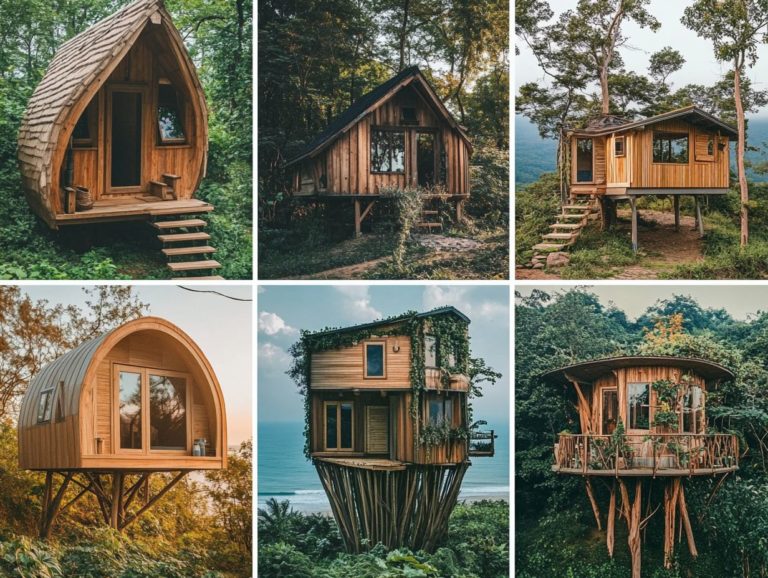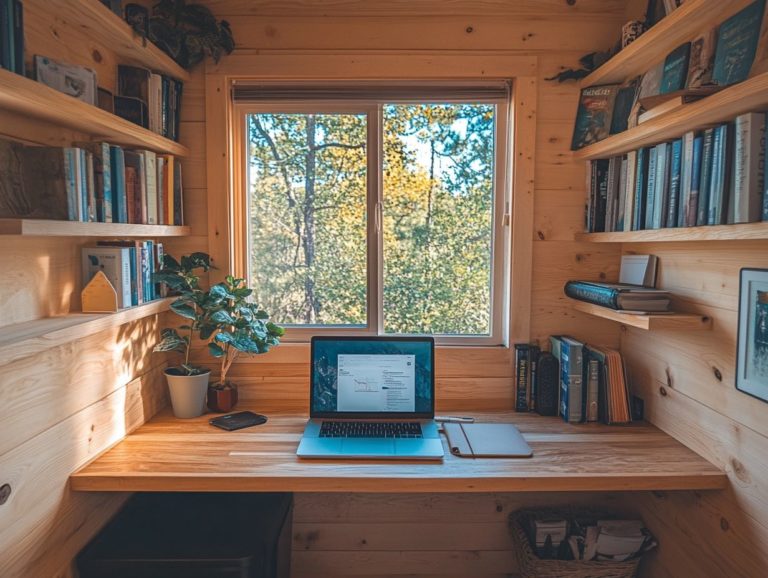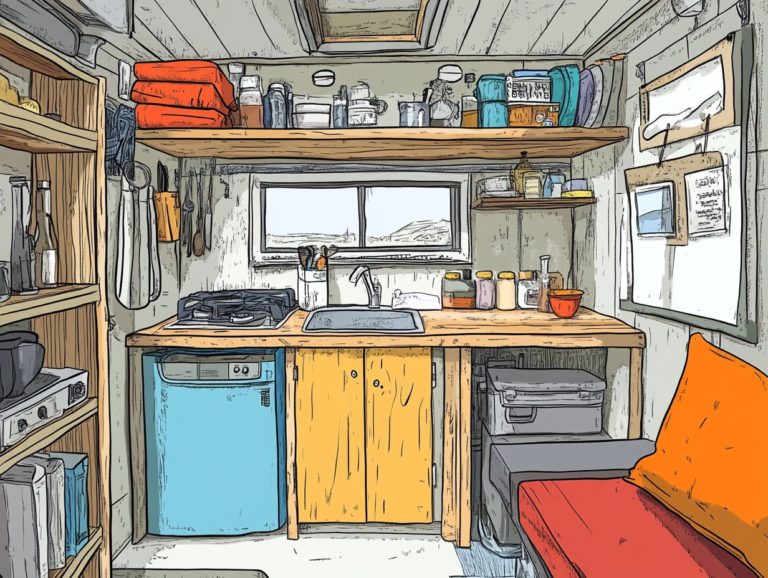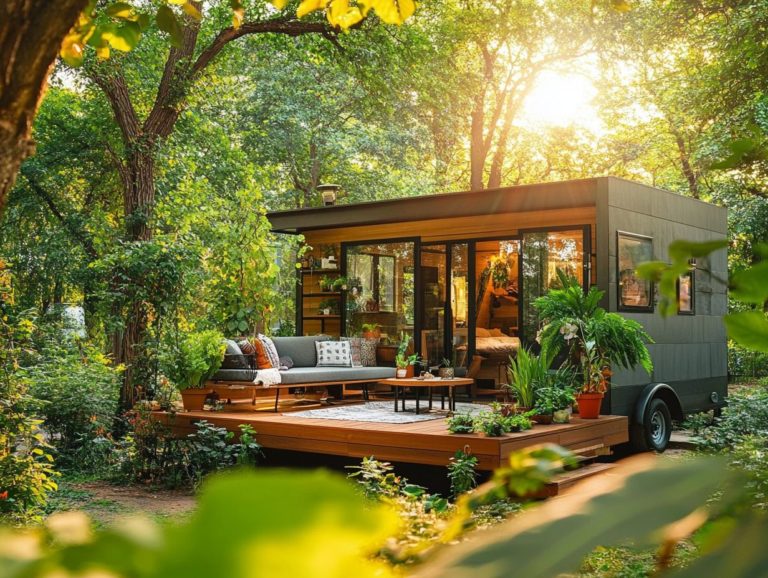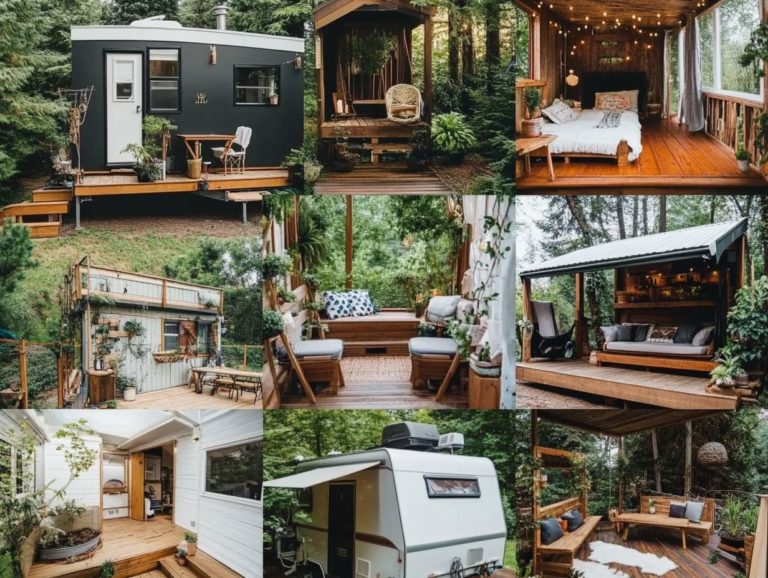Minimalist Decor Ideas for Tiny Houses
In a world where space is increasingly limited, using minimalism in your home decor presents an elegant solution for crafting a tranquil living environment, especially within the tiny house movement.
This exploration delves into the advantages of minimalist decor in tiny houses, showcasing how it enhances functionality while reducing clutter and stress.
Get ready to discover the fundamental principles of minimalism, essential elements to keep in mind, and practical tips for seamlessly integrating this style into various rooms of your home, including Scandinavian and bohemian designs.
Whether you’re downsizing or seeking a more serene space, perhaps influenced by modern coastal aesthetics, you’ll find inspiration that sparks your creativity!
Contents [hide]
- Key Takeaways:
- Benefits of Minimalist Decor in Tiny Houses
- Principles of Minimalist Decor
- Key Elements of Minimalist Decor
- Incorporating Minimalist Decor in Different Rooms
- Frequently Asked Questions
- 1. What is minimalist decor and why is it popular for tiny houses?
- 2. How can I incorporate minimalist decor into my tiny house?
- 3. Do I have to sacrifice style for minimalism in my tiny house?
- 4. What are some key elements of minimalist decor for tiny houses?
- 5. Can I still have a cozy and inviting atmosphere with minimalist decor in my tiny house?
- 6. How can I maintain a minimalist aesthetic in my tiny house over time?
Key Takeaways:
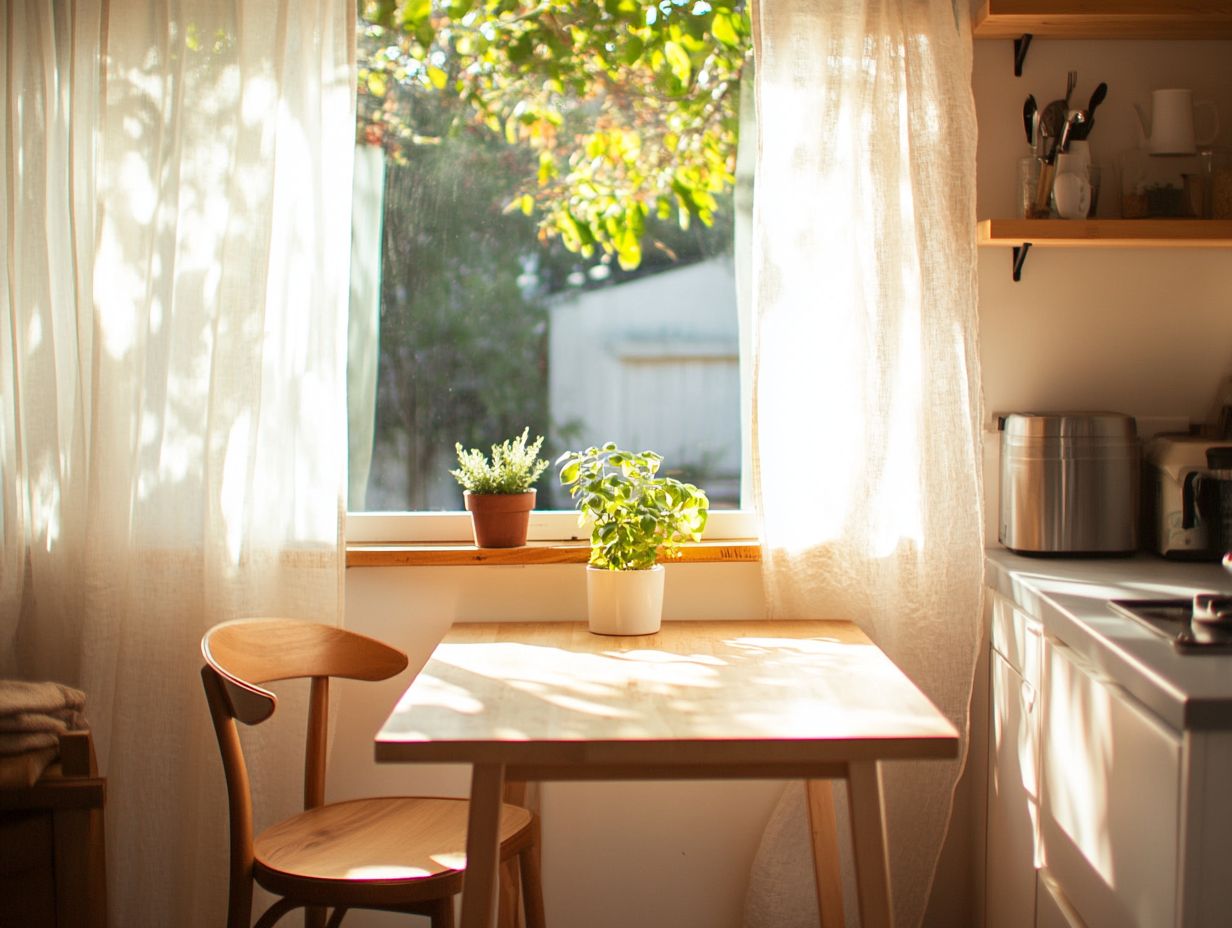
- Maximize space and functionality in tiny houses with minimalist decor and creative space-saving solutions.
- Reduce clutter and stress by incorporating minimalist principles like simplicity, neutral colors, and natural elements.
- Incorporate minimalist decor in all rooms of a tiny house, including the living room, kitchen, dining area, bedroom, and bathroom, while maintaining a cozy charm.
What is Minimalism in Home Decor?
Minimalism in home decor invites you to embrace a lifestyle centered around simplicity and functionality. This design philosophy resonates with the principles of the tiny house movement, compact living, and minimalist living. It champions natural materials, creating a serene atmosphere that nurtures tranquility and aligns with good environmental practices.
By focusing on the essentials, minimalism allows you to express your personal style while cultivating an uncluttered and calming environment.
This approach celebrates clean lines and a neutral palette, drawing inspiration from nature and English country cottage aesthetics to enhance the cozy charm of your space. Incorporating natural textures like wood and linen elevates the aesthetic and aligns with eco-friendly principles, enhancing the feel of rustic treehouses and cozy micro-living environments.
This thoughtful selection of materials and colors fosters a harmonious environment that soothes the mind and supports good environmental practices, particularly in the context of bohemian decor and modern coastal themes. Ultimately, minimalism encourages you to create a meaningful home that reflects your values and serves as a peaceful retreat from the chaos of modern life, celebrating the elegance of stylish midcentury modern design.
Benefits of Minimalist Decor in Tiny Houses
The benefits of minimalist decor in tiny houses and cozy micro-living spaces extend well beyond aesthetics; they significantly enhance your lifestyle and the surrounding environment. By embracing compact living, you cultivate a sense of freedom and creativity that harmonizes beautifully with the core principles of the tiny house movement.
When you prioritize functional design and innovative space-saving solutions, you not only optimize your living space but also promote a good way of life, creating a stylish midcentury modern or industrial design atmosphere.
Ready to start your minimalism journey? Explore more resources and tips to help you along the way!
Maximizing Space and Functionality
Maximizing space and functionality is essential in tiny houses and stylish rustic cabins, where every square foot is precious. Innovative design solutions will transform your living environment into an efficient and good-looking sanctuary.
By incorporating multipurpose furniture that is, furniture that serves more than one purpose and creative space-saving ideas, including options that reflect bohemian decor or industrial design, you can turn compact areas into functional spaces that showcase your personal style and preferences.
Imaginative building designs truly make a difference. For instance, integrating lofted beds can free up valuable floor space, while expandable dining tables add versatility for entertaining guests in your modern coastal or rustic cabin aesthetic.
Cleverly designed built-ins, like fold-down desks and hidden storage solutions, not only help to minimize clutter but also enhance the overall flow of your living area, showcasing architectural excellence in both style and function.
Embracing natural light through strategically placed windows and skylights can amplify the perceived space, making your tiny home feel open and inviting—an important aspect of effective minimalist living. These innovative approaches illustrate that successful tiny living isn’t merely about downsizing; it’s about elevating the art of living comfortably within compact dimensions while incorporating smart design solutions for tiny house living and embracing eco-friendly principles.
Reducing Clutter and Stress
Reducing clutter and stress is a remarkable advantage of adopting minimalist decor in tiny homes. This approach transforms your space into a serene sanctuary that nurtures mental well-being and relaxation, perfect for cozy micro living.
By embracing minimalist living, you can cultivate a cozy charm reminiscent of English country cottage aesthetics. This style minimizes distractions and fosters a peaceful atmosphere an essential refuge in today s fast-paced world.
This approach not only enhances the aesthetic appeal of your space but also encourages a sense of clarity and focus. It allows you to truly appreciate your surroundings while enjoying vibrant colors. With carefully curated decor and intentional choices, the beauty of minimalist design lies in its ability to create functional spaces inspired by midcentury modern and Scandinavian design aesthetics with fewer items.
This simplicity invites tranquil moments, giving your mind the opportunity to unwind. The warmth exuded by thoughtfully selected furnishings and textures contributes to a comforting environment, reinforcing the notion that a serene sanctuary isn’t just about what you see, but also about how you feel within that space, enhancing the bohemian style you desire.
Principles of Minimalist Decor
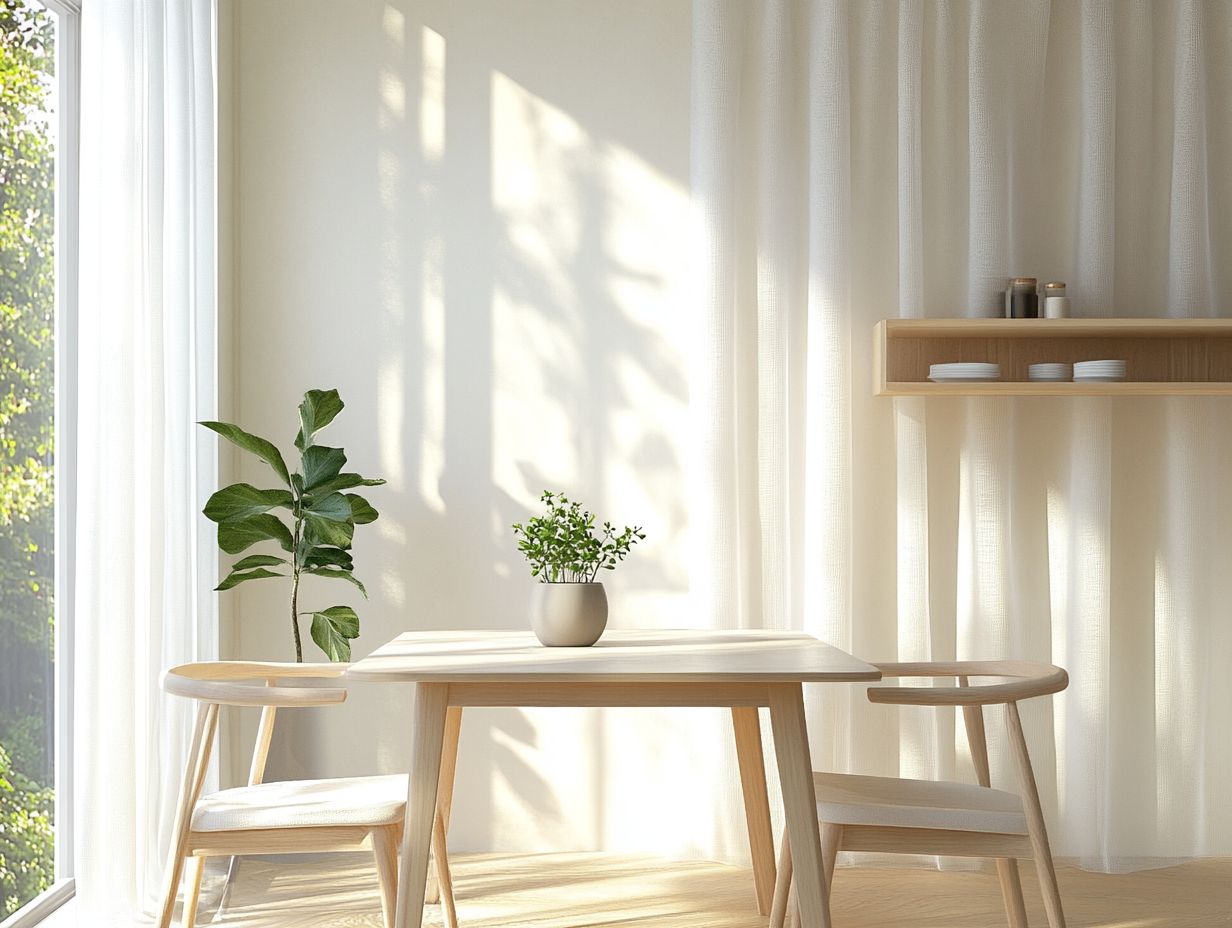
The principles of minimalist decor center on functional design and the deliberate use of space, encouraging a lifestyle that prioritizes quality over quantity. This makes it perfect for compact living.
By emphasizing natural light and incorporating a calming color palette inspired by vibrant colors, you can create environments that reflect personal expression and foster a serene atmosphere.
This approach shines particularly in tiny houses and rustic cabins, where each design decision profoundly influences both aesthetic appeal and functionality.
Simplicity and Functionality
Simplicity and functionality lie at the core of minimalist decor. Your focus shifts to creating stylish yet practical spaces tailored for compact living.
By seamlessly incorporating elements of functional design alongside chic midcentury modern aesthetics and industrial design features, you can achieve a harmonious balance between beauty and utility.
This approach not only maximizes your space but also cultivates a sense of tranquility, allowing you to thrive in environments that are free from clutter, distractions, and excess. Create a cozy home with the elegance of midcentury modern pieces, which feature clean lines and refined materials.
Each item you choose serves a dual purpose enhancing visual appeal while ensuring usability. In this way, minimalist decor transforms your small spaces into versatile havens, where form and function coexist in perfect harmony.
This makes your everyday living more enjoyable and efficient, whether in a rustic treehouse or a compact home. Act now to create your serene sanctuary!
Neutral Colors and Natural Elements
In minimalist decor, neutral colors and natural elements create a calming color palette that enhances the aesthetic of your space. This style is perfect for Scandinavian design enthusiasts. It supports a green lifestyle by using natural materials and establishes a stylish decor that resonates with tranquility and peace, crucial in the tiny house movement.
By incorporating materials like wood, stone, and organic textiles, your design pays homage to nature while inviting a sense of warmth and groundedness. This reflects the cozy charm of rustic treehouses. The soft hues of beige, white, and gray provide flexibility for various textures, enhancing visual appeal without overwhelming your senses. This approach celebrates the principles of cozy micro-living.
As you create environments embodying serenity and sustainability, embracing neutral tones is essential for crafting a harmonious sanctuary. This space exudes elegance and reflects your commitment to eco-conscious living, fitting perfectly within the tiny house movement.
Key Elements of Minimalist Decor
The key elements of minimalist decor center on practicality and aesthetics. This highlights the value of multipurpose furniture and clever storage solutions, enhancing the functionality of cozy micro-living spaces. This is ideal for rustic cabins and stylish midcentury modern homes.
Natural light elevates the atmosphere and transforms your home into a warm and inviting sanctuary. This is essential for maximizing the charm of small spaces while reflecting personal expression.
Smart Furniture That Saves Space!
Incorporating multipurpose furniture and innovative storage solutions is key to achieving stylish decor in minimalist living spaces, especially in tiny homes and rustic cabins where space is precious. By leveraging space-saving ideas, you can optimize your rustic cabin aesthetic or modern coastal vibe while ensuring functionality remains a priority.
This approach transforms your overall design and fosters a more organized, clutter-free environment. Imagine a beautifully crafted coffee table that doubles as a storage chest it’s the perfect blend of style and practicality, enhancing the serene atmosphere of your cabin, where charming architectural details shine.
Wall-mounted shelves provide ample display space for your favorite rustic decor items or stylish midcentury modern accents while keeping the floor clear and open. A fold-out dining table can transform a compact area during meals and tuck away conveniently afterward, maximizing your available space in tiny homes or cozy micro-living setups. For more ideas, check out these top 10 tiny house interior design hacks.
These thoughtful design choices let you embrace your love for nature while enjoying a comfortable, stylish home that reflects modern coastal and bohemian styles.
Lighting and Textiles
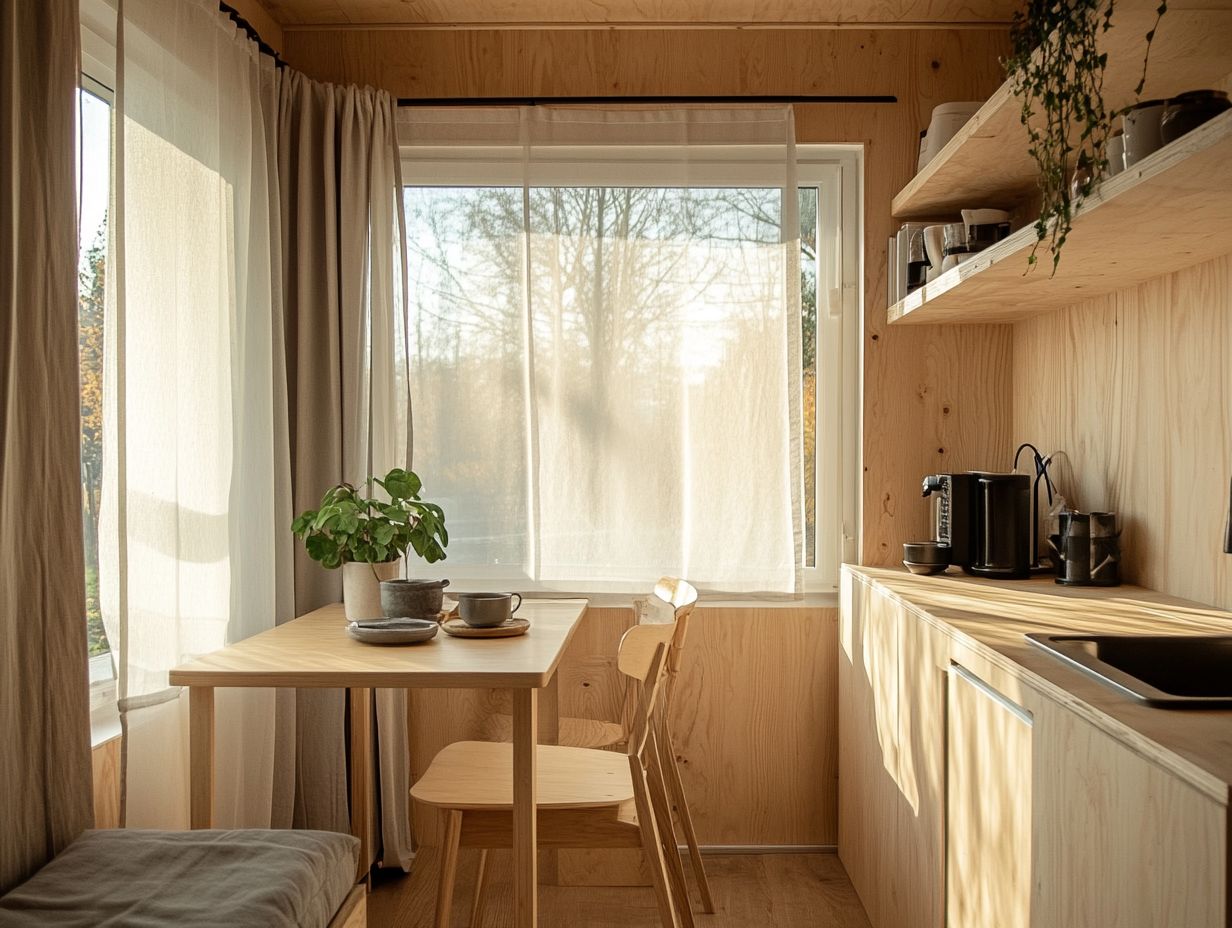
Using lighting and carefully selected textiles can significantly elevate the ambiance of your minimalist living spaces. Natural light is vital for crafting a soothing color palette. Selecting textiles that harmonize with your design can evoke a cozy charm that invites relaxation.
Consider soft, sheer curtains that filter sunlight, allowing diffused light to warm the room and create an inviting atmosphere. Incorporating textiles like plush throws, natural fiber cushions, and organic linen adds texture and reflects modern coastal aesthetics without overwhelming the senses.
This harmonious interplay between lighting and textiles enhances the tranquil hues and cultivates an intimate environment, fostering a genuine sense of comfort and well-being. These deliberate design choices show that minimalist decor can be both visually pleasing and cozy, transforming your space into the perfect sanctuary for unwinding after a long day.
Start incorporating these tips today to create your own serene sanctuary!
Incorporating Minimalist Decor in Different Rooms
Incorporating minimalist d cor in various rooms elevates the sense of harmony and cohesion throughout your home. This transformation turns each space into a functional design that complements the essence of efficient living space.
Apply minimalist principles to create a stunning transformation in your spaces, enhancing both visual appeal and comfort.
Living Room
The living room is a central hub where minimalist decor shines. Use multipurpose furniture to maximize functionality and create an inviting atmosphere.
Embrace natural light by adding sheer curtains to brighten the room. This enhances the clean lines and shapes characteristic of midcentury modern design.
Select furniture that serves multiple purposes, like a chic sofa bed or a coffee table with built-in storage. These choices conserve space while promoting an uncluttered look essential to minimalist design.
Thoughtful arrangement of artwork and decor that echo these principles can help your living room transform into a serene retreat reflecting simplicity and sophistication, while incorporating elements of bohemian decor.
Kitchen and Dining Area
In your kitchen and dining area, a practical layout is essential for creating an efficient and stylish space that aligns beautifully with minimalist decor principles.
Embrace clever storage solutions and prioritize efficient living space to transform your culinary space into a haven that encourages ease of use and enjoyment.
Consider integrating multi-purpose furniture like expandable dining tables and stackable chairs. These pieces offer flexibility without compromising aesthetics.
Open shelving is another excellent option; it not only showcases your beautiful dishware but also keeps essential items within easy reach. Choosing kitchen gadgets that serve dual purposes helps you maximize storage solutions while keeping clutter at bay.
Utilize vertical space with hooks and racks every inch of your kitchen deserves to be optimized. Together, these elements create a harmonious atmosphere, allowing you to enjoy a serene sanctuary perfect for both cooking and entertaining.
Bedroom
The bedroom is your personal retreat, and embracing minimalist decor can create a cozy charm that transforms it into a serene sanctuary for relaxation.
Utilizing a calming color palette and thoughtfully selected decor elements fosters a peaceful environment that encourages restful moments.
When you embrace simplicity, you eliminate visual clutter, allowing your mind to unwind after a long day. Soft neutrals, gentle pastels, or muted earth tones can significantly enhance ambiance, promoting tranquility and comfort.
Incorporating natural textures, such as a soft woven throw or organic linen bedding, adds depth to your minimalist approach without overwhelming your senses. The strategic use of negative space (the empty areas around objects that create a sense of openness) invites a sense of freedom, turning your bedroom into a calm oasis where you can rejuvenate both body and spirit, embodying sustainable living. For those living in compact spaces, consider these tips for decluttering your tiny house to maximize your environment.
Bathroom

In your bathroom, embracing functional design is essential for achieving a minimalist decor that highlights cleanliness and tranquility. By letting in more natural light and adopting eco-friendly practices, you can create a spa-like atmosphere that promotes relaxation and well-being.
To cultivate this serene environment, think about incorporating elements like large mirrors that reflect sunlight, enhancing brightness while making the space feel more expansive. Choosing sustainable materials, such as bamboo and recycled glass, not only elevates the aesthetic but also aligns with your eco-conscious values, reflecting modern trends in sustainable methods.
Keep surfaces clutter-free by utilizing hidden storage solutions. Make sure every item has its perfect spot. Adding some greenery improves air quality, contributing to a fresh and inviting atmosphere while reinforcing nature s role in minimalist design.
This meticulous attention to detail will help transform your bathroom into a calming retreat, catering to those who appreciate the tiny house movement.
Frequently Asked Questions
1. What is minimalist decor and why is it popular for tiny houses?
Minimalist decor is a design style that focuses on simplicity, usefulness, and minimal use of decor and furniture. It is popular for tiny houses because it makes living spaces feel bigger and promotes a clutter-free, peaceful living environment, embodying the spirit of compact spaces.
2. How can I incorporate minimalist decor into my tiny house?
You can incorporate minimalist decor into your tiny house by decluttering and only keeping essential items, choosing a neutral color palette, using multifunctional furniture, and incorporating storage solutions.
3. Do I have to sacrifice style for minimalism in my tiny house?
No, you don’t have to sacrifice style for minimalism in your tiny house. There are many ways to add personality and charm to a minimalist space, such as incorporating textures, using statement pieces, and adding elements of nature, embracing bohemian style.
4. What are some key elements of minimalist decor for tiny houses?
Key elements of minimalist decor for tiny houses include open spaces, natural light, clean lines, and a neutral color palette. It’s also important to focus on usefulness and organization in the design, ensuring that compact living is effectively implemented.
5. Can I still have a cozy and inviting atmosphere with minimalist decor in my tiny house?
Yes, you can still have a cozy and inviting atmosphere with minimalist decor in your tiny house. Adding soft textures, warm lighting, and personal touches can help create a comfortable and welcoming space, reflecting personal expression.
6. How can I maintain a minimalist aesthetic in my tiny house over time?
To maintain a minimalist aesthetic in your tiny house, regularly declutter and reassess your belongings, avoid impulse purchases, and prioritize usefulness over aesthetics when choosing decor and furniture. It’s also important to create a designated space for everything to avoid clutter build-up.

